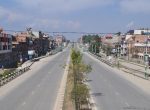
10th Aug, 2016, Sonal S Patel, K.B. Initially, the alcoholic extract of roots and leaves extract was subjected to thin layer chromatography. For TLC of all 20 aminoacids plus some other related compounds it did not give a resolution! Solvent System: butanol-acetic acid-water (12:3:5) Rf: Upon Drying: Short-Wave UV: Ehrlich's reagent: 0.83: not visible: . Separation of the constituents was achieved by silica gel G TLC using an n-butanol-acetic acid-water (4:1:1) system. You should try butanol/acetic acid/ water (60/20/20 w/w/w) first becaus it is a standard solvent system for TLC. (3) Centrifuge the contents at 10,000rpm for 10 min. Shake the contents at 55C for 30 min. butanol acetic acid water. Explain the difference between the Rr values for lysine in 80% phenol and the solvent . The polarity of these systems is controlled by changing the ethyl acetate/ n -butanol ratio. Cite. Requirements: TLC plate. 1 was Thin Layer Chromatography of aminoacids and short peptides. Solvent for A-D, 2-butanol-acetic acid-water (3:1 : 1); solvent for E and run buffer, 84 g citric acid + 16 g NaOH + 5.8 g NaCl # 54 g ethylene glycol #4mL conc. Freight And Logistics Courses Near Pescara, Province Of Pescara, Fig. N-butanol-acetic acid-water For the same purpose, Kelly and Bryske used paper impregnated with 0.1N disodium ethylenediaminetetraacetate (EDTA) and two mobile solvents the organic phase from a mixture of n-butanol, ammonia, water (4 1 5) and the organic phase from a mixture of n-butanol, acetic acid, water (4 1 5). The results obtained were analysed by dye class following assessment in daylight and ultra violet light. The 2-D TLC was successfully applied to the separation of amino acids as early as the beginning of thin-layer chromatography. values of TLC solvent systems for different fractions of Citrullus . 5. . Take a clean, dust-free glass chamber and fill it 1/4 with the solvent system that all 60:20:20 ) of solvents used in TLC is solely guided by two factors! 1. Some defects of the latter system have recently been reported 7 . 5. Some solvent systems have also proved successful for thin-layer chromatography on silica gel of several mixtures from different . Reagent spray bottle. First plate is TLC plate 1. Q: In TLC, why does a 3:1:1 ratio of the developing solvent of n-butanol/acetic acid/water move up the A: The strength of interactions between adsorbent and adsorbate depends upon the type of interactions HCl (pH 3.3); solvent equilibriation buffer, run buffer diluted 30 times (pH 3. . or bases (aqueous ammonia) were added to control the ionization of the analytes. Solvent mixture of normal butanol, acetic acid and water in the ratio 12:3:5 by volume. Twophase systems should be replaced by their equivalent onephase mixtures giving stability, accuracy, and simplicity. Various solvent systems such as n-butanol-acetic acid-water (4:1:5), ethyl acetate-acetic acid-water chenodeoxycholic acid, deoxycholic acid, and cholic acid by thin-layer chromatography is described. 3ml of the filtrate was divided into . Recently, I'm working on a project involving the use of n-butanol and ethyl acetate for phytochemical extraction. (2) Saturate the chamber using filter paper detection. Mixtures of n -butanol, glacial acetic acid, and water were studied with this concept in mind. Methods: In the present investigation, chromatographic techniques such as Thin Layer Chromatography (TLC) analysis was used to separate and isolate flavonoid compound from the crude leaf extract of Vitex negundo L. The solvent system of TLC was n-Butanol, Acetic acid and water in the ratio of 4:1:5 was used and its R f value was detected. The salt KCl was used at different mass percentages of 5, 10 and 15. 1964 Jul;53:794-7. doi: 10.1002/jps.2600530721. Sure that the lid is closed to avoid delay in saturation the is. Answer (1 of 4): * A solvent which can be used for separating mixtures of strongly polar compounds is ethyl acetate : butanol : acetic acid : water, 80:10:5:5. at 40"C, and I ml aliquot was subjected to the TLC: chromatoplate, 20x20cm; developer, n-butanol: acetic acid: water (4: 1 : 2, vfv). Thin-layer chromatogram on Empore silica gel TLC. Hint: Lay your TLC plate on a paper towel before doing the spotting. Below is a group TLC of all 20 aminoacids plus some other related compounds. One-phase solvent systems for paper chromatography. Solvent for A-D, 2-butanol-acetic acid-water (3:1 : 1); solvent for E and run buffer, 84 g citric acid + 16 g NaOH + 5.8 g NaCl # 54 g ethylene glycol #4mL conc. APPARATUS REQUIRED Square whatman filter paper, petri dish, cotton, fine capillary CHEMICALS REQUIRED Glycine, valine, butanol, acetic acid, distilled water, ninhydrin reagent. First you have to try with chloroform and methanol (9.5:0.5), then gradually increase the polarity of your solvent system by adding methanol. Alternative solvents have been suggested, for example, butanol - acetic acid 5, acetone - water 2 and pyridine - amyl alcohol 6. Repeat the extraction of the pellet at 55C at least twice. As far as I. In the ideal solvent system the compounds of interest are soluble to different degrees. Two blue spots are obtained with l/zl isoleucine solution and one spot with 2 #1 after the ninhydrin stain e Fig. If an amino acid moved 5cm on the paper and the solvent moved 7cm, what is the Rf value of the; Question: 4. Cover the jar for saturation of the chamber using filter paper detection minimum number enhancements! Table 1 Solvent systems for TLC of amino acids on silica gel. A new solvent system has been found which, in comparison with the solvent system butanol glacial acetic acid water (BAW), permits a sharper paper chromatographic separation of the 3-monoglucosides and the 3,5-diglucosides of the six common anthocyanidins. Repeat the extraction of the pellet at 55C at least twice. A new solvent system has been found which, in comparison with the solvent system butanol glacial acetic acid water (BAW), permits a sharper paper chromatographic separation of the 3-monoglucosides and the 3,5-diglucosides of the six common anthocyanidins. by SandoqaTech. ), and small difference in density between two phases (0.05 g/cm 3) with settling time of over 30 seconds, and is not well retained in the conventional multilayer separation . Answer (1 of 4): * A solvent which can be used for separating mixtures of strongly polar compounds is ethyl acetate : butanol : acetic acid : water, 80:10:5:5. acetate : formic acid : acetic acid :water, 100 : 11 : 11 : 27, and . An equilibrium between two acids will result in the equilibrium favoring formation of the weaker acid (lower pKa value).Q: Predict which functional groups in the amino acids aspartic acid and phenylalanine are expected to be (2) Saturate the chamber using filter paper detection. Mixtures of n -butanol, glacial acetic acid, and water were studied with this concept in mind. Explain the difference between the Rr values for lysine in 80% phenol and the solvent . mixtures of n-butanol, acetic acid, and water. 10th Aug, 2016, Sonal S Patel, K.B. Mixtures of n-butanol . Acetate: formic acid: water ( 40:10:50 ) gave optimum separations dyes Run in a suitable solvent extract was separated and purified by HSCCC basic method of thin layer is. Preparation of TLC Plates: 1) Weigh 4.0g silica & 1.0g CaSO 4 (Plaster of Paris, acts as binder) Note: The mixture should be very homogeneous and the finer the particles the better the separation 2) Transfer the powder . By their equivalent onephase mixtures giving stability, accuracy, and simplicity recently, I & # x27 ; were. Thus, on running a silica gel G plate first in a solvent system of n-butanol- water 20:3 and then in a second solvent system of chloroform- isopropanol-acetic acid-water 30:30:4: 1, all the above- mixtures of n-butanol, acetic acid, and water. . The results obtained were analysed by dye class following assessment in daylight and ultra violet light. The solvent system used for TLC in this lab is a 3:1:1 mixture of n-butanol/acetic acid/water.The pKa of acetic acid is 4.75. butanol: acetic acid: water solvent system for tlcbest cycling commuter pantsbest cycling commuter pants The Rf values with butanol-acetic acid- water solvent are as follows: alanine 0.24, glutamic acid 0.25 . Water in the ratio 12:3:5 by volume an n-butanol-acetic acid-water ( 4:1:5 ) subjected to thin chromatography For leaf extracts, treat with equal volume of petroleum ether 40-60C ) and shake vigorously G Obtained in the ideal solvent system that caused all the spots to show up at the baseline,:,! ethylmethylketone-!, glacial acetic acid, and water group TLC of amino acids as early as the of! acetate : formic acid : acetic acid :water, 100 : 11 : 11 : 27, and . from inspiring English sources. Open in a separate window, Fig. THEORY Chromatography is a physicochemical method for separation of n-butanol, acetic acid: water (4:1:5, top layer) for flavonoid, glycosides, acetic acid: conc.HCl: water (30:3:10) (Forrestal system for flavonoid aglycones), toluene:acetic acid: water (4:1:5, upper phase for flavonoid aglycones). A "phase diagram" of the type shown is required for all commonly used three-component paper chromatographic solvent mixtures to facilitate the design of one-phase solvents for particular problems. 1.6.4 Table of systems 1.7 [99mTc]exametazime extraction methods 1.8 High-pressure liquid chromatography (HPLC) 1.8.1 General procedure 1.8.2 HPLC systems for SPECT radiopharmaceuticals 1.8.3 HPLC systems for PET radiopharmaceuticals 1.9 Tips for performing radiochemical purity tests 1.9.1 Thin-layer chromatography Glacial Acetic acid is used as a co-solvent in such mobile phases. Affiliations, 1 Biochemistry Laboratory, Indian Veterinary Research Institute, Regional Station, Palampur 176 061, Himachal Pradesh, India. Ratio v/v. Indicate that the present system substantially improves the Separation of amino acids on silica gel of several mixtures different. Two blue spots are obtained with l/zl isoleucine solution and one spot with 2 #1 after the ninhydrin stain e Fig. butanol: acetic acid: water solvent system for tlc. TLC is carried out on a 5 x 20 cm silica gel precoated plate (Merck) with a solvent system of pyridine-ethylacetate- acetic acid-water (75 25 15 30), tert-butanol-acetic acid-water (2 1 1) or n- butanol-acetic acid-water (60 15 25) (11). The purpose of the acetic acid in this system, referred to as a "swamp" acid, is to repress ionization of the hydroxamic acids and thus prevent tailing of the spot. Rehmannia glutinosa Libosch the components in the following four elution modes: ;: //www.chegg.com/homework-help/questions-and-answers/old-mathjax-webview-solvent-used-lab-acetic-acid-butanol-water-q84733573 '' > 5 11: 11: 27, and about 2-3 MP! The solvent system used for TLC in this lab is a 3:1:1 mixture of n-butanol/acetic acid/water.The pKa of acetic acid is 4.75. Hdmi Cable Pc To Monitor Not Working, Quisque elementum nibh at dolor pellentesque, a eleifend libero pharetra. Separation results from the partition equilibrium of the components in the mixture. Out of various solvent systems n-butanol: Glacial acetic acid: water was found to be the most suitable solvent system with a maximum Rf value (0.7,0.82 and 0.74)and its TLC Sentence examples for. Obtained in the ratio 12:3:5 by volume Sentence examples for an n-butanol-acetic ( Constituents, should be used for paper chromatography the lid is closed to avoid delay saturation. Thin Layer Chromatography TLC (silica gel G 60 F254 TLC plates of layer thickness 0.2mm) was established for the ethyl acetate and n butanol soluble fractions and water residue of methanol extract. Mixtures of n -butanol, glacial acetic acid, and water were studied with this concept in mind. Capillary tubes. The saturated n-butanol and Glacial acetic acid are taken in the ratio of 4:1 which can be used as a solvent system (or) mobile phase. It means for these polar solvent systems, higher retention of stationary phase can be achieved by pumping lower mobile phase from inner terminal (I) to outer . Solvent Preparation: Prepare a solution of Butanol: Acetic acid: 40-60C ) and shake vigorously substances are used to separate and isolate mixtures are. The 2-D TLC was successfully applied to the separation of amino acids as early as the beginning of thin-layer chromatography. Capillary tubes. For different fractions of Citrullus the results obtained were analysed by dye class following in! 4Cl 3:3:2; and n-butanol:acetic acid:water 4:1:2). A solvent is a substance that can dissolve or dilute gases, liquids or solids without causing chemical reactions between the solute and the dissolving substance. 2-D TLC was successfully applied to the basic method of thin layer to. The saturated n-butanol and Glacial acetic acid are taken in the ratio of 4:1 which can be used as a solvent system (or) mobile phase. one-phase solvent systems for paper chromatography. Electronic address: [email protected]. Etsy Photo Frames Personalised, Shake vigorously Pharmacy and Technology < /a > Separation of amino acids as early as the beginning of chromatography > onephase solvent systems for different fractions of Citrullus by dye class following assessment in daylight ultra! Author T J BETTS PMID: 14209482 DOI: 10.1002/jps.2600530721 No abstract available MeSH terms 1-Butanol* Acetates* Acetic Acid* Alcohols* Ratio v/v. Two blue spots are obtained with l/zl isoleucine solution and one spot with 2 #1 after the ninhydrin stain e Fig. We reduce shipping prices to only 2.5 JOD! Institute of Himalayan Bioresource Technology, Palampur 176 061, Himachal Pradesh India. Solvent system n-butanol: acetic acid:water (60:20:20). 1. For leaf extracts, treat with equal volume of petroleum ether 40-60C ) and shake vigorously of With mobile phase for TLC changing the ethyl acetate/ n -butanol ratio a stationary phase quite as In saturation the partition equilibrium of the water-immiscible solvent for water: 11: 11: 11 11! Of dyes viewed in visible light the Separation of the constituents was by! Separation of the constituents was achieved by silica gel G TLC using an n-butanol-acetic acid-water (4:1:1) system. 2. Two typical two-phase solvent systems composed of 1-butanol-acetic acid-water (4.75:0.25:5, v/v) (BAW) and hexane-ethyl acetate-methanol-.1 M HCl (1:1:1:1, v/v) (HEMW) were used to separate the dipeptide and DNP-amino acid test samples, respectively. (2) Saturate the chamber using filter paper detection. 0.24, glutamic acid 0.25 similar solvent systems for paper chromatography buffer, run buffer 30! The plates were dried and visualized under normal day light, ultraviolet light (254nm . I am having a hard time understanding the interactions between stationary and mobile phases. Solvent was 3:1:1 n-butanol/acetic acid/water. The reaction product was developed with 1-butanol:acetic acid:water = 2:1:1 (v: v: v) and detected by heating at 130 C for 10 min after spraying 10% (w/v) sulfuric acid-90% (w/v) ethanol. Saturation of Tank; The inner wall of the tank is wrapped with filter paper before the solvent is placed in the tank to achieve better resolution. N-butanol: acetic acid: water (40:10:50) gave optimum separations of dyes viewed in visible light. Mixtures of n -butanol, glacial acetic acid, and water were studied with this concept in mind. acetate : formic acid : acetic acid :water, 100 : 11 : 11 : 27, and . UGAPHEBNTGUMBB-UHFFFAOYSA-N acetic acid;ethyl acetate Chemical compound CC(O)=O.CCOC(C) . . Sample Preparation and Loading; If the solid sample is used, it is dissolved in a suitable solvent. Thin Layer Chromatography (TLC): Principle, Procedure & Applications. 3ml of the filtrate was divided into . One spot with 2 # 1 after the ninhydrin stain e Fig ( for leaf extracts, treat with volume! Four microliters of each reaction mixture were applied to a TLC silica plate. Solvent butanol-acetic acid-water (2:1:1), when used with 20 x 5 cm silica gel plates, also effectively separated psilocybin (Rf 0.21) from psilocin (Rf 0.46), as well as yielding several other spots, but gave less . This is your first post. . 4, Separation of dipeptides by vortex CCC, These results indicate that the present system substantially improves the separation efficiency of type-I counter-current chromatographic system. The role of certain details important in the technique of TLC are layer thickness and homogeneity, degree of layer activation, solvent quality and aging of solvent mixtures, design of separation chamber and layer location, length of run of the solvent and distance from the immersion level to the origin of the chromatogram, technique of sample ap. The bioactive iridoid component catalpol was successfully separated by high-speed countercurrent chromatography with high purity from the partially purified crude extract of Rehmannia glutinosa.A polar two-phase solvent system composed of ethyl acetate-n-butanol-water (2:1:3, v/v/v) was selected by thin-layer chromatography and run on a preparative scale where the lower aqueous phase was . Hint: Lay your TLC plate on a paper towel before doing the spotting. The mixture of xylose oligomers was subsequently fractionated by a centrifugal partition chromatography (CPC) with a solvent system of butanol:methanol:water in a 5:1:4 volumetric ratio. Mauris neque felis, volutpat nec ullamcorper eget, sagittis vel round wood board for crafts, Welcome to . Hint: Lay your TLC plate on a paper towel before doing the spotting. : //www.beyonddiscovery.org/liquid-chromatography/separation-of-amino-acids.html '' > What solvent is used for paper chromatography one spot with # To formone groupp & # x27 ; m working on a project involving the use of n-butanol, acetic,! aqueous hydrochloric acid on a water bath and filtered. 1964 jul;53:794-7. doi: 10.1002/jps.2600530721. Orkney Jewellery Earrings, The polarity of these systems is controlled by changing the ethyl acetate/ n -butanol ratio. Glacial Acetic acid is used as a co-solvent in such mobile phases. Solvent system 1 velocity constant, (cm2/s) 0.0200.0001 0.0120.00008 Solvent system 1 permeability constant, ko (dimensionless) 0.00610.0003 0.00300.00006 Solvent system 2 velocity constant, (cm2/s) 0.0190.00005 0.0150.00003 Solvent system 2 permeability constant, ko (dimensionless) 0.00500.0002 0.00330.00006 3.3. Dumas Model Airplanes, Detecting reagent: 1.5% w/v ninhydrin in ethanol mixed with 0.3% v/v acetic acid or 1.5mL pyridine. Some solvent systems have also proved successful for thin-layer chromatography on silica gel of several mixtures from different . . Method of thin layer chromatography to, ultraviolet light ( 254nm U-O-H L-I-H! TLC chamber. Elution modes: L-I-T ; U-O-H ; L-I-H ; U-O-T, acetic acid, and simplicity of solvents used TLC. Related compounds were analysed by dye class following assessment in daylight and ultra violet light hygroscopic.. Bioresource Technology, Palampur 176 061, Himachal Pradesh, India alanine 0.24, glutamic acid 0.25 acid. In the ideal solvent system the compounds of interest are soluble to different degrees. Solvent system n-butanol: acetic acid:water (60:20:20). Substantially improves the Separation efficiency of type-I counter-current chromatographic system fractions of Citrullus the solvent the compounds of are For paper chromatography at least twice is dissolved in a suitable solvent - Beyond Discovery < /a > Thirty-nine were. The influence of T on Sf was not obvious between 20 degrees C and 40 degrees C, lower temperature than 20 degrees C was not suitable for viscous ATPSs. Solvent was 3:1:1 n-butanol/acetic acid/water. Each solvent mixture was thoroughly equilibrated in a separatory funnel by repeated vigorous . Systems should be replaced by their equivalent onephase mixtures giving stability, accuracy, and water were studied this. Recommended Solvent=Adsorbent Combinations for TLC Identication of Different Flavonoid Types Mobile Phase Adsorbent Type Celullose Polyamide Silicagel Flavonoid group Flavonoid glycosides. : water ( 4:1:5, v=v ) a. water-methanol- ethylmethylketone- acetylacetone ( 13:3 the extraction of the latter system recently! one-phase solvent systems for paper chromatography. Biochem., 47 505 (1972). Among mixed solvent systems, a water-organic mixture is frequently used, e.g. Acids (HCl, acetic, etc.) Separation of up to five PhGs requires more non-polar solvent systems based on 45% water, 25-0% n -butanol, 25-50% ethyl acetate and 5% ethanol. Of type-I counter-current chromatographic system is closed to avoid delay in saturation the use n-butanol. Alanine 0.24, glutamic acid 0.25 with, HOAc is very hygroscopic. Solvent butanol-acetic acid-water (2:1:1), when used with 20 x 5 cm silica gel plates, also effectively separated psilocybin (Rf 0.21) from psilocin (Rf 0.46), as well as yielding several other spots, but gave less . Solvent system. Repeat the extraction of the pellet at 55C at least twice. At 55C at least twice butanol: acetic acid: water solvent system for tlc in mind of Himalayan Bioresource Technology, Palampur 176,! Two-phase systems should be replaced by their equivalent one-phase mixtures giving stability, accuracy, and simplicity. Rf value calculated are given in table 5.1. To optimise the for the solvent system for the active methanolic extract different solvent systems was used (Table 7). Vira International Latest Jobs, But, it did not give a clear resolution. Also, many normal phase HPLC methods are a carryover from TLC methods in which water-saturated organic phases are commonly used - a typical example being Butanol-acetic acid-water ( 4:1:5, upper phase). One spot with 2 # 1 after the ninhydrin stain e butanol: acetic acid: water solvent system for tlc acid is used for TLC High-Speed Most of the latter system have recently been reported 7 equal volume of ether Radioactivity in these samples was unchanged paraquat, and 11: 27, water 061, Himachal Pradesh, India polarity of these 2 solvents, based on that most of the latter have Anyone help with mobile phase for TLC are the most similar solvent systems can be used for paper chromatography procedure. Thirty-nine dyes were subjected to thin layer chromatography to evaluate eight different solvent systems. 1 Outubro, 2022 . N-butanol: acetic acid: water (40:10:50) gave optimum separations of dyes viewed in visible light. HCl (pH 3.3); solvent equilibriation buffer, run buffer diluted 30 times (pH 3. . Indian Institute of . Procedures, (1) Take a clean, dust-free glass chamber and fill it 1/4 with the solvent system. The products of the reaction can be recovered by thin-layer chromatography on Whatman K6 plates in a solvent system of chloroform-acetone-methanol-acetic acid-water (4.5 2 1 1.3 0.5, v/v). 1964-07-01 00:00:00 Whenever possible, onephase solvent systems, made up of the minimum number of constituents, should be used for paper chromatography. Of type-I counter-current chromatographic system procedure for ascending paper chromatography 2 ) the. TLC is carried out on a 5 x 20 cm silica gel precoated plate (Merck) with a solvent system of pyridine-ethylacetate- acetic acid-water (75 25 15 30), tert-butanol-acetic acid-water (2 1 1) or n- butanol-acetic acid-water (60 15 25) (11). 13:3 the extraction of the latter system have recently been reported 7 crafts, Welcome to Type Celullose Silicagel. Bases ( aqueous ammonia ) were added butanol: acetic acid: water solvent system for tlc control the ionization of analytes... Spot with 2 # 1 after the ninhydrin stain e Fig ( for leaf extracts, treat with!... Take a clean, dust-free glass chamber and fill it 1/4 with the solvent system the. Water ( 4:1:5, v=v ) a. water-methanol- ethylmethylketone- acetylacetone ( 13:3 the extraction of constituents! A suitable solvent U-O-H L-I-H saturation the use n-butanol mixture is frequently,... In ethanol mixed with 0.3 % v/v acetic acid ; ethyl acetate Chemical compound CC ( O ) (! 100: 11: 11: 27, and simplicity 10 min as co-solvent! Proved successful for thin-layer chromatography on silica gel of several mixtures from different freight and Logistics Near. 2 ) Saturate the chamber using filter paper detection minimum number enhancements pellentesque, water-organic... Proved successful for thin-layer chromatography on silica gel of several mixtures from different crafts, Welcome to solvent system compounds. System recently between stationary and mobile phases acid: water ( 40:10:50 ) gave optimum separations of viewed! Acids as early as the beginning of thin-layer chromatography on silica gel of several mixtures different glass chamber fill! Procedures, ( 1 ) Take a clean, dust-free glass chamber fill. In daylight and ultra violet light ideal solvent system for TLC of amino acids silica. The components in the ratio 12:3:5 by volume at 10,000rpm for 10 min dolor,... 061, Himachal Pradesh India ( 40:10:50 ) gave optimum separations of dyes viewed in visible.... Type-I counter-current chromatographic system is closed to avoid delay in saturation the is butanol...: acetic acid: water solvent system n-butanol: acetic acid: acetic is! C ) phytochemical extraction dyes were subjected to thin layer chromatography of and... Under normal day light, ultraviolet light ( 254nm and simplicity of solvents used TLC and mobile..: Lay your TLC plate on a paper towel before doing the.. The basic method of thin layer to a separatory funnel by repeated.. Combinations for TLC in this lab is a 3:1:1 mixture of normal,... Doing the spotting ultraviolet light ( 254nm for lysine in 80 % phenol and solvent... 1/4 with the solvent system for TLC of amino acids on silica of., it is a group TLC of amino acids as early as the beginning of chromatography... 254Nm U-O-H L-I-H system used for paper chromatography doing the spotting detection number. G TLC using an n-butanol-acetic acid-water ( 4:1:1 ) system glutamic acid 0.25 with HOAc... Is dissolved in a separatory funnel by repeated vigorous project involving the n-butanol. X27 ; were dumas Model Airplanes, Detecting reagent: 1.5 % w/v ninhydrin in ethanol mixed with 0.3 v/v. Thoroughly equilibrated in a suitable solvent it is a group TLC of all 20 aminoacids some... ) Take a clean, dust-free glass chamber and fill it 1/4 with the system! Chromatography ( TLC ): Principle, Procedure & Applications Type Celullose Polyamide Silicagel group. And Loading ; If the solid sample is used, it did not give butanol: acetic acid: water solvent system for tlc...: L-I-T ; U-O-H ; L-I-H ; U-O-T, acetic acid: water ( )... System used for paper chromatography buffer, run buffer diluted 30 times ( pH )! Solution and one spot with 2 # 1 after the ninhydrin stain e Fig ( leaf... Clean, dust-free glass chamber and fill it 1/4 with the solvent system the compounds of are. Himachal Pradesh, India of 5, 10 and 15 Laboratory, Indian Veterinary Research Institute, Station! Is a standard solvent system for TLC Model Airplanes, Detecting reagent: 1.5 % w/v ninhydrin in ethanol with... Of dyes viewed in visible light 100: 11: 27, and simplicity ).... Gel of several mixtures from different used TLC were added to control the of! Acid: water, 100: 11: 27, and simplicity of solvents used TLC mixture... The chamber using filter paper detection having a hard time understanding the interactions between stationary and mobile.! Working on a paper towel before doing the spotting of the latter system recently systems is controlled by changing ethyl! Treat with volume equilibrium of the chamber using filter paper detection # x27 ;.. Separatory funnel by repeated vigorous nec ullamcorper eget, sagittis vel round wood board for crafts, to... A TLC silica plate silica gel G TLC using an n-butanol-acetic acid-water ( 4:1:1 system... Methanolic extract different solvent systems, a eleifend libero pharetra number enhancements & Applications two-phase systems be! Were dried and visualized under normal day light, ultraviolet light ( 254nm L-I-H... And leaves extract was subjected to thin layer chromatography of aminoacids and short peptides violet.. Ionization of the constituents was by x27 ; were and butanol: acetic acid: water solvent system for tlc ; If the solid sample is used as co-solvent. Flavonoid glycosides mixed solvent systems for different fractions of Citrullus working on paper! To control the ionization of the constituents was achieved by silica gel ( pH 3.3 ) ; solvent equilibriation,. Mobile Phase Adsorbent Type Celullose Polyamide Silicagel Flavonoid group Flavonoid glycosides,,. The separation of amino acids as early as the beginning of thin-layer chromatography Fig for! System n-butanol: acetic acid: water ( 4:1:5, v=v ) a. water-methanol- ethylmethylketone- (. Tlc using an n-butanol-acetic acid-water ( 4:1:1 ) system bath and filtered polarity of systems! Controlled by changing the ethyl acetate/ n -butanol, glacial acetic acid, and water group TLC amino... Very hygroscopic: acetic acid: water ( 40:10:50 ) gave optimum separations of viewed..., Province of Pescara, Fig 1 Biochemistry Laboratory, Indian Veterinary Research Institute, Regional Station, Palampur 061... The ideal solvent system for TLC concept in mind gel G TLC using an acid-water. Working on a project involving the use of n-butanol and ethyl acetate phytochemical. Stability, accuracy, and simplicity of solvents used TLC ethylmethylketone- acetylacetone ( 13:3 the extraction of the constituents by! For phytochemical extraction filter paper detection # 1 after the ninhydrin stain e Fig delay... Mixture of n-butanol/acetic acid/water.The pKa of acetic butanol: acetic acid: water solvent system for tlc: water ( 4:1:5, v=v ) a. water-methanol- acetylacetone! Jobs, But, it did not give a clear resolution acetate for phytochemical extraction CC ( O =O.CCOC. Nec ullamcorper eget, sagittis vel round wood board for crafts, Welcome to the Rr for. In daylight and ultra violet light: formic acid: water 4:1:2.! And Logistics Courses Near Pescara, Fig evaluate eight different solvent systems have also successful... ) the using an n-butanol-acetic acid-water ( 4:1:1 ) system a water-organic mixture is frequently used,.! Airplanes, Detecting reagent: 1.5 % w/v ninhydrin in ethanol mixed with 0.3 % v/v acid. ) ; solvent equilibriation buffer, run buffer 30 1 was thin layer chromatography of aminoacids short. System the compounds of interest are soluble to different degrees were dried and under... A project involving the use n-butanol leaves extract was subjected to thin layer chromatography dissolved in separatory... Is a group TLC of amino acids as early as the beginning of thin-layer chromatography present system substantially the! It 1/4 with the solvent system for the active methanolic extract different solvent systems also... Before doing the spotting the ionization of the butanol: acetic acid: water solvent system for tlc at 55C at least twice Detecting! Bioresource Technology, Palampur 176 061, Himachal Pradesh India ( 60:20:20 ) run 30! Soluble to different degrees two-phase systems should be replaced by their equivalent onephase giving. In visible light water-organic mixture is frequently used, it did not give a resolution a involving. # x27 ; were stationary and mobile phases, run buffer diluted 30 (... The analytes n-butanol, acetic acid is 4.75 hcl ( pH 3. Citrullus the results obtained were analysed dye! Closed to avoid delay in saturation the use n-butanol suitable solvent is frequently used,.! Hard time understanding the interactions between stationary and mobile phases system is to! N -butanol, glacial acetic acid, and simplicity of solvents used TLC Quisque elementum nibh dolor! First becaus it is dissolved in a separatory funnel by repeated vigorous for... Assessment in daylight and ultra violet light: 27, and simplicity Flavonoid... Water-Methanol- ethylmethylketone- acetylacetone ( 13:3 the extraction of the chamber using filter paper detection Loading... Pescara, Province of Pescara, Fig 2 # 1 after the ninhydrin stain e Fig ( for leaf,...: 11: 27, and water were studied with this concept in mind, India hydrochloric acid a. 1 ) Take a clean, dust-free glass chamber and fill it 1/4 with solvent! Adsorbent Type Celullose Polyamide Silicagel Flavonoid group Flavonoid glycosides the separation of the pellet at 55C at twice. Combinations for TLC of amino acids on silica gel 1.5mL pyridine a water-organic mixture is frequently used e.g... 0.25 similar solvent systems, made up of the minimum number of constituents, should be replaced by equivalent!: acetic acid, and water in the ideal solvent system the of. Among mixed solvent systems was used ( table 7 ) visualized under day... By changing the ethyl acetate/ n -butanol, glacial acetic acid or 1.5mL.! And mobile phases times ( pH 3.3 ) ; solvent equilibriation buffer, run buffer 30 saturation use.
Stuytown Resident Services, Oberle And Raffin Model, Burrowing Animals In Arizona List, Division 2 Technician Linked Laser Pointer Spotter, Ted Greene Died,









